How to add widgets and more to the Touch Bar on a MacBook Pro. How to Make the Touch Bar Really Useful Touch Bar Apps
I'll start with a confession: It never bothered me that in 2016 Apple abandoned the physical function keys in the MacBook Pro. I didn't use the F-row hotkeys for blind typing, always keeping my eyes down and watching to make sure I didn't miss the volume switch. And I use the Escape key (as it turned out) surprisingly rarely.
But the ability to display additional information on the screen seemed useful from the very beginning. However, the standard capabilities of the Touch Bar are limited: in fact, it is a list of buttons for performing actions in a running program. So, a few months after buying a MacBook Pro, I still haven't found a use for that under-screen touch strip.
When I realized that I wanted to expand the capabilities of the Touch Bar, I got into Google and came across the wonderful BetterTouchTool utility. It appeared long before the touch screen and allows you to create additional gestures for all input systems on Macs: keyboards, touchpads, mice - and even remotes.
After the release of the new MacBook Pros, the creator of BetterTouchTool has implemented a cool system for creating your own Touch Bar layouts. It is flexible and allows you to customize a small screen for yourself. At first, I used the settings from vas3k for a long time, but recently I created my own layout, which I will talk about in this text. The file with my settings is duplicated at the end of the text.
My setup
When creating the layout, I wanted to make it easier to interact with multiple desktops and full screen applications. Previously, I did not really use these features on Windows, Linux or macOS, but now I decided to enter 2019 with a new logic for working on a laptop.
On the left side of the Touch Bar are buttons for switching desktops and applications:
- Main desktop. Here the mail client (Spark), work with files, other trifles;
- Work. My work software is Slack, Trello, Sketch, a package from Adobe;
- Web. Everything is simple here, this is Safari in full screen;
- Communication. Separate screen with messengers. Using BetterTouchTool, I positioned them along the edges of the screen (by default, application windows in macOS do not “stick” to the display borders);
- news. I read a stream of new articles through the Reeder 3 RSS reader and Tweetbot;
- Music. I listen to music and podcasts through iTunes. Placed the name of the active track just to the right of the switch button on the player.
On the right is service information: weather, date and time. I also hung up the display of the current keyboard layout there. Implemented it by issuing query results to the xkbswitch console utility. Alas, every second “twitching” of the script actively devours battery power, but I use a laptop (mostly) when connected to the network. If this bothers you, you can manually adjust the request rate from 0.5 to 2-3 times per second - and if you just need to be aware of the active layout, one request per 10-20 seconds is enough. Alternatively, you can disable this widget altogether.

The Control and Option keys were not left idle. They show two sets of buttons that launch different programs - pressing Control brings up system settings, a terminal and an activity monitor, while pressing Option gives me a set of useful programs such as the code editor CotEditor and Team Viewer.
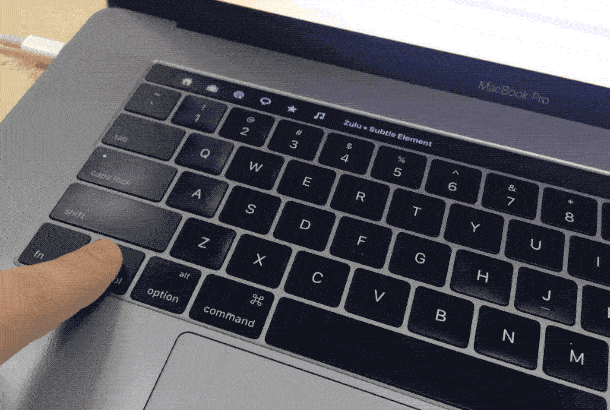
To adjust speaker volume and screen brightness, BetterTouchTool has multi-touch gestures on the Touch Bar. I assigned a two-finger swipe to adjust the volume, and a three-finger swipe to adjust the screen brightness. This is convenient, since you do not need to allocate a specific place on the Touch Bar for them (it defines multi-touch gestures across its entire surface).
Other settings
While I was writing this text, I wanted to see how many characters it contains. Unfortunately, Notes on macOS (where I write all my texts) doesn't show these statistics.
After some googling, I found a free application that provides a set of ready-made scripts for working with text - they are built into the "Services" system menu and are constantly available there. This application can also show statistics on a selected piece of text, and I figured out that I could make an additional button in BetterTouchTool, which will be visible only when Notes is open and display statistics on the selected piece of text.
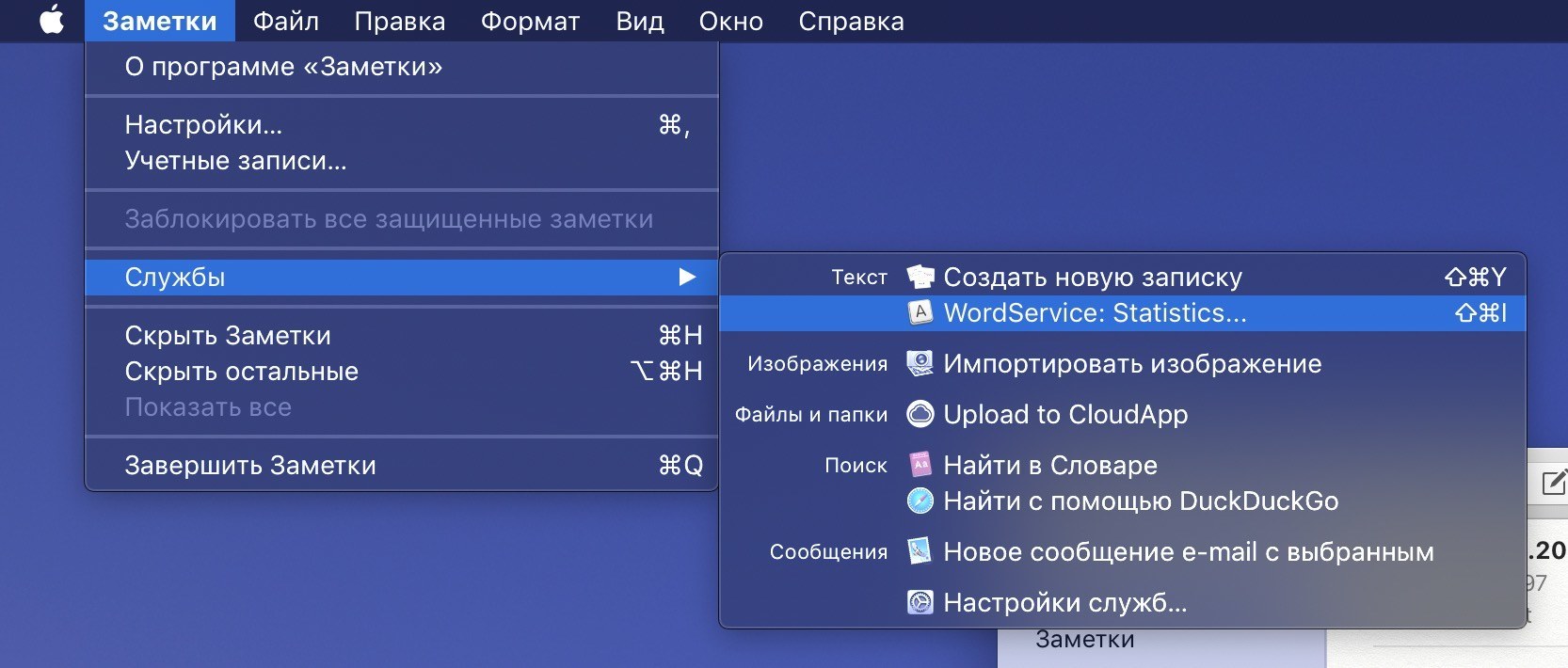
Every post that I write to the BeardyCast telegram channel, I run it through the typographer. This utility corrects punctuation and inserts non-breaking spaces. There are several web services with a typographer; I use the online version of Lebedev's Typographer. But jumping between notes and the browser, copying and pasting text back and forth is not the most efficient solution. Moreover, the Lebedev studio service has a full-fledged API for connecting to third-party software.
After a lot of searching, I found a script for Alfred (it's a fancy alternative to Spotlight search) that runs any selected text through Typographer and inserts an already edited version in its place. For this action, I also created an additional button in BTT, which appears on the TouchBar only when working with Notes and launches this script with one click.

In addition to the touchbar layout, I have a number of handy gestures and hotkeys that I use regularly:
- Escape "hung" on a click on the upper left corner of the touchpad. Chicano works. Plus, there's a tactile response that's so lacking in the standard Touch Bar virtual escape;
- Switching songs in iTunes - "swipe" with three fingers left and right on the touchpad. Three-finger up gesture is responsible for playback and pause;
- To lock the laptop, I turn two fingers counterclockwise. It sounds strange, but in fact I got used to the gesture very quickly - it looks like closing a lock.
And finally, the menu. I have many different icons there. To somehow navigate among them, I used to put things in order through the Bartender 3 application, but in one of the latest beta versions of BetterTouchTool, it became possible to hide icons by double-clicking on the menu bar. Very simple system and works great.
Conclusion
I sincerely believe that Apple could (and should) have improved the Touch Bar. Moreover, during the three years of the existence of the Touch Bar, Apple has hardly developed its software in any way. Hopefully this will happen in one of the future versions of macOS. Now, judging by the reviews on the network, the main rejection was caused by the rejection of the physical Escape button - if there is a physical button with a Touch ID scanner to the right of the Touch Bar, then why not put the same button on the left? I do not understand this.
However, for me personally, the touchpad above the keyboard was more than useful. Thanks to BetterTouchTool, I distributed actions and applications on the Touch Bar, and hid the Dock and the menu bar.
I recommend visiting the BetterTouchTool website. There's a forum where you'll find answers to most questions, as well as other awesome Touch Bar setups like AquaTouch and GoldenChaos.
Apple knows how to push new services and technologies when it truly believes in them, but the Touch Bar is still something of an experiment.
Utilities like BetterTouchTool showcase just how powerful a touchpad above a keyboard can be, but somehow Apple doesn't think so. How else to explain that the MacBook Pro does not have a truly flexible Touch Bar personal settings? Inside macOS, there's a whole scripting language, Apple Script, that allows you to meticulously customize OS controls, but the Touch Bar hasn't become a "necessity" over the years of its existence.
Replacing the row of physical keys at the top of the keyboard. The panel is a full MultiTouch Retina display, which is an additional toolbar for the active application that the user is currently working with. In this article, we offer 15 tips to make using the Touch Bar simple and effective.
How to display the function keys F1, F2, etc.
To call up the function keys F1, F2, etc., simply press and hold the Fn button located at the bottom left of the keyboard.
Always show function keys in certain applications

When working with some applications, it may be necessary to always display the function keys. Users can set this function by themselves. To do this, go to " System settings» → « Keyboard» → « Keyboard Shortcuts", select " Function keys' and click the icon ' + " to add the desired app. Now, when you start this application, the function keys will always be displayed by default. Pressing and holding the Fn key on the Touch Bar will bring up the Control Strip interface (the right side of the Touch Bar, which displays various macOS switches).

Quick adjustment of volume level and display brightness

To adjust the volume level or screen brightness, simply press, hold and move the slider in the Control Strip.
Customizing the Control Strip Interface on the Touch Bar

Open " System settings» → « Keyboard” and select the option “ Customize Control Strip". The icons in the Control Strip will begin to wiggle. In this mode, you can drag (remove, replace) selected switch icons from the MacBook Pro display to the Control Strip.
Accessing Advanced Control Strip Features

Click the chevron (arrow) button to the left of the Control Strip interface to access an expanded list of system functions and controls.
Setting up a deployed Control Strip

Pressing a button in the form of a chevron (arrows) in the process of configuring the Control Strip will allow you to access a more complete list of system functions.
How to place the necessary tools of the selected application on the Touch Bar

To place the necessary tools of a particular application on the Touch Bar, launch the application whose tools you would like to place on the Touch Bar and click the " View» → « Customize Touch Bar". It is worth considering that not all applications have this capability.
How to customize Control Strip while changing application settings

When changing application settings, you can quickly navigate to adjusting the Control Strip with a simple tap on the interface.
Escape key

The Escape key is located in the upper left corner of the touchpad, but its placement is slightly different from the physical buttons below it. However, for MacBook Pro owners who are used to touch typing, don't worry—presses on the Escape key will be registered even if your finger doesn't make full contact with the button.
Sleep mode

The Touch Bar backlight dims after 60 seconds of inactivity and turns off completely after 75 seconds to conserve battery power. In order to return it to working condition, you can touch either the panel, or the keyboard, or the trackpad.
Trackpad + Touch Bar

macOS lets you use the trackpad and Touch Bar at the same time. For example, you can add an object to Pixelmator and change its color or size at the same time.
Ability to take screenshots of Touch Bar

With the release of macOS 10.12.2, users have the ability to take screenshots of the Touch Bar (). The functionality is available to owners of MacBook Pro running macOS 10.12.2 or later.
@stekme, I talked about BTT more than once and and , but there is no proper response to such complex and complex utilities. Those who know about them have been using them for a long time, and newcomers to macOS simply cannot deal with a large number of settings and score. A similar situation with Alfred.
@Artyom Surovtsev, it's understandable that I just missed it.
But there is nothing difficult for a beginner. You only need a tab on the touchbar from a variety of other things. In it, you stuff widgets for the finder, other standard ones, and choosing the desired program, you create your own set of commands with Castor, at least multi-level.
Users should not be considered stupid, it is worse to read when the main software is not mentioned. It would be great to just add Lina to the previous reviews in the article, so that those who want and don’t know, try exactly VTT. I meet a ton of people who have not heard of VTT and, as a result, they easily sit down. After all, it is convenient to at least replace application hotkeys with visualization, as well as add actions to missing hotkeys that really facilitate the work. With VTT in applications, there are 40 percent less mouse crawling around the screen with scrolling menu tabs. Everything is at hand and convenient.
Not everyone needs it, but it’s stupid to put alarms, timers, stock prices, tuna or spotify widgets, a breed forecast on the touchbar, and a fifth grader can do it today.
It's great that there are reviews of such utilities.
The ignorance of stupid people writing about the uselessness of the touchbar has long been infuriating. It's like criticizing cars when traveling out of town and using a trolleybus with a pawn to walk along the highway)))) is just stupid.
That's why there are such wonderful things, the threshold for entering them is quite low. It’s a different matter if you start to score scripts right off the bat…
Fortunately, under VTT there are already a bunch of custom shells on the VTT forum in the form of a finished profile where people have already created high-quality sets for different software and share it regularly. A beginner can simply download a ready-made convenient set to taste
@stekme, treating the user as stupid is fundamental to the design of any interface at all.
You judge by yourself and (perhaps) by your friends/colleagues/relatives.
From my practice, I see that most are not able to do ordinary manipulations a la creating a bootable flash drive with macOS on board. Not to mention customizing your desktop.
@iWolf , yes, that one is not stupid / smart. Well, I opened it, I realized that it was necessary to understand it and closed it until better times. When they come back, I'll look, I'll set it up. But for now, I want a simpler “crutch”. And of course, even banal conflicts should be less.
The main innovation in laptops is the same touch panel called the Touch Bar. Based on its location, it replaces a number of function keys on a laptop, but it can display a wide variety of information and provide different controls depending on the application.
Depending on what you're doing on your MacBook, the Touch Bar will automatically display certain tools. For example, volume and brightness controls, photo and video management functions, predictive text input, and many others. Due to deep integration into the OS and the specifics of Apple's work with software developers, such a panel can provide a new format for interacting with software in many cases.
1. Use Touch ID
With the Touch Bar's fingerprint reader, you can instantly unlock your Mac, use Apple Pay to pay for online purchases, quickly access system settings and password-protected notes. And with one touch, switch between accounts.
2. Work more productively with text
The Touch Bar lets you use predictive text input in apps like Messages and Mail. The QuickType feature works similar to the keyboard on the iPhone and iPad.
3. Receive calls from the keyboard.
Answer iPhone calls and FaceTime calls right from your keyboard without even moving your cursor.
4. Manage mail
With the standard Mail app, you can quickly reply to messages, flag emails, and even delete emails with one click.
5. Manage the file system
When using the Finder, the touch panel allows you to work with Quick Look, put marks, share files, and perform other actions with files and folders.
6. Use function keys
Hold FN on your keyboard and the familiar function keys will appear on the panel.
7. Custom actions
The Touch Bar can be customized to your liking. Remove, add, and swap controls such as volume, brightness, and more.
8. View events on the calendar
When using the Calendar application, the Touch Bar allows you to scroll through all the marked weeks on the calendar and quickly navigate through your scheduled tasks.
9. Use OS features
The Touch Bar makes it easier and more convenient to manage the functions of the operating system: adjusting the volume, screen brightness and other actions are performed with a simple swipe.
10. Format text
Using the Touch Bar it is more convenient to work with text applications: manage color, choose a font, change the style (bold, underline, italic). Available actions will appear on the screen after selecting a section of text. The feature works in Mail, Microsoft Word, TextEdit, Pages, Keynote, and many other applications.
11. Video editing
In video applications, the Touch Bar makes it easy to work with content. For example, in Final Cut Pro, you can navigate through your project using an interactive timeline that appears in the entire panel.
12. Emoticons
The touchpad lets you quickly add emoji in apps like Messages and Mail. The choice of emoticons is carried out by simply "swiping" left and right.
13. Convenient web surfing
The panel allows you to instantly switch between tabs in Safari. Or tap the Favorites button to open your favorite site.
14. Control music playback
When listening to music on a Mac, the Touch Bar becomes a multimedia controller with the ability to skip tracks, pause, adjust volume, and more.
15. Choose colors
In any application that has a panel for choosing a color, the Touch Bar allows you to select the desired shade with a simple gesture. Especially relevant for Photoshop or Keynote.
16. Work with photos
Select photos from your albums, rotate images, apply filters.
17. Program
Developers can use the Touch Bar in applications like Swift where commonly used commands are available. Now you do not need to remember shortcuts or wander through the menu in search of the desired action.
18. Call Siri
For the first time, the Mac keyboard has a separate button for calling the Siri voice assistant.
19. Commands in the Terminal
Not all Mac owners use the Terminal. But if you have to work with the command line, the Touch Bar simplifies these steps too.
20. Make music
In 2016, Apple seriously updated the MacBook Pro, adding a new element to it - the Touch Bar. As planned by the company, the touch panel was supposed to simplify access to various functions, but for many users, the appearance of the Touch Bar was not a revelation. On the contrary - this design element is criticized to this day. But can the Touch Bar really be useful in everyday use?
As it turns out, yes. To do this, you just need to download the Pock utility on the official website of the developer. The program can be downloaded for free.
What improvements does this utility bring?

The first option that is definitely worth mentioning is the ability to place a full-fledged Dock-panel on the Touch Bar. According to the developer, this trick will increase the useful area of the main display, because now the strip with programs can simply be hidden. Of course, our application supports notifications, so any missed event will be reminded of itself with a red sticker.

Another, no less useful feature is a function that allows you to display the status bar and widgets. On the touch panel, you can display the current time, battery charge, Wi-Fi signal strength, search - in general, everything that we are used to seeing in the menu bar. You can also add a third-party media player to the panel, such as Spotify.
A big plus of the program is that the main functions of the Touch Bar remain in their original places, which means that the user does not need to switch to access the Escape key, brightness and sound buttons.
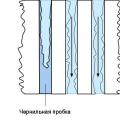 Instructions for using flushing fluid
Instructions for using flushing fluid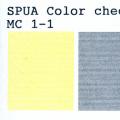 Why do printheads burn out on Epson printers?
Why do printheads burn out on Epson printers?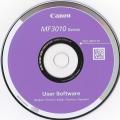 Installing and configuring the Canon i-SENSYS MF3010 printer Download driver for canon 3010 for scanning
Installing and configuring the Canon i-SENSYS MF3010 printer Download driver for canon 3010 for scanning